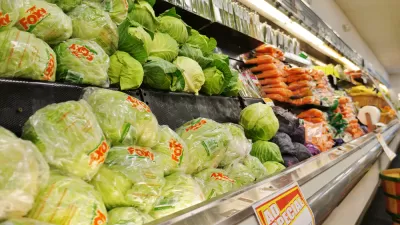Nathanael Johnson reports on what makes healthy grocery stores succeed in food deserts.

While a lot of media attention has been poured over the new Whole Foods store in Midtown district of Detroit, Nathanael Johnson focuses on the success of Metro Foodland, a grocery store that “opened in the midst of Detroit’s depopulation and found a way to thrive while offering healthy foods” for the past 30 years. Contrary to popular notions, “It’s not that grocery executives turn up their noses at poorer neighborhoods; they just couldn’t figure out how to make money there.”
Referring to the success of Metro Foodland, Johnson notes that the key to succeeding as a grocery store in food desert areas is to provide what the customers are used to buying instead of “assuming that people will change their food habits as soon as they have access to brown rice...Even Whole Foods altered its product mix in Detroit, offering fewer organic items and instead emphasizing local foods.”
Success also requires incentivizing health: “Metro Foodland, for example, offers a lot of information about health. It has partnered with a chef to provide classes and healthy shopping lists. It has a small community room full of events. And the store has a rewards card that gives members money back on healthy foods, creating a subtle push toward those items.”
Traditional grocery stores depend on customers who buy weeks' worth of groceries and hauling them home in their cars. “In cities, especially in lower-income neighborhoods, however, people don’t buy as much per trip...But here’s the thing: Those people are going to the store much more frequently and spending almost as much as their more affluent neighbors.”
You also need to think small, but sell a lot: “...fewer items in a smaller space, and an intense engagement with customers to make sure those are the products that will sell.”
FULL STORY: Making food deserts bloom takes more than just a baptism of kale

Alabama: Trump Terminates Settlements for Black Communities Harmed By Raw Sewage
Trump deemed the landmark civil rights agreement “illegal DEI and environmental justice policy.”

Planetizen Federal Action Tracker
A weekly monitor of how Trump’s orders and actions are impacting planners and planning in America.

The 120 Year Old Tiny Home Villages That Sheltered San Francisco’s Earthquake Refugees
More than a century ago, San Francisco mobilized to house thousands of residents displaced by the 1906 earthquake. Could their strategy offer a model for the present?

Ken Jennings Launches Transit Web Series
The Jeopardy champ wants you to ride public transit.

BLM To Rescind Public Lands Rule
The change will downgrade conservation, once again putting federal land at risk for mining and other extractive uses.

Indy Neighborhood Group Builds Temporary Multi-Use Path
Community members, aided in part by funding from the city, repurposed a vehicle lane to create a protected bike and pedestrian path for the summer season.
Urban Design for Planners 1: Software Tools
This six-course series explores essential urban design concepts using open source software and equips planners with the tools they need to participate fully in the urban design process.
Planning for Universal Design
Learn the tools for implementing Universal Design in planning regulations.
Clanton & Associates, Inc.
Jessamine County Fiscal Court
Institute for Housing and Urban Development Studies (IHS)
City of Grandview
Harvard GSD Executive Education
Toledo-Lucas County Plan Commissions
Salt Lake City
NYU Wagner Graduate School of Public Service




























